Perfect for day or night, the Twilight Cardigan is a modern take on a fall staple – the button-down cardigan! Scroll down for this free crochet cardigan pattern and step-by-step video tutorial, or purchase the ad-free, printable PDF here!
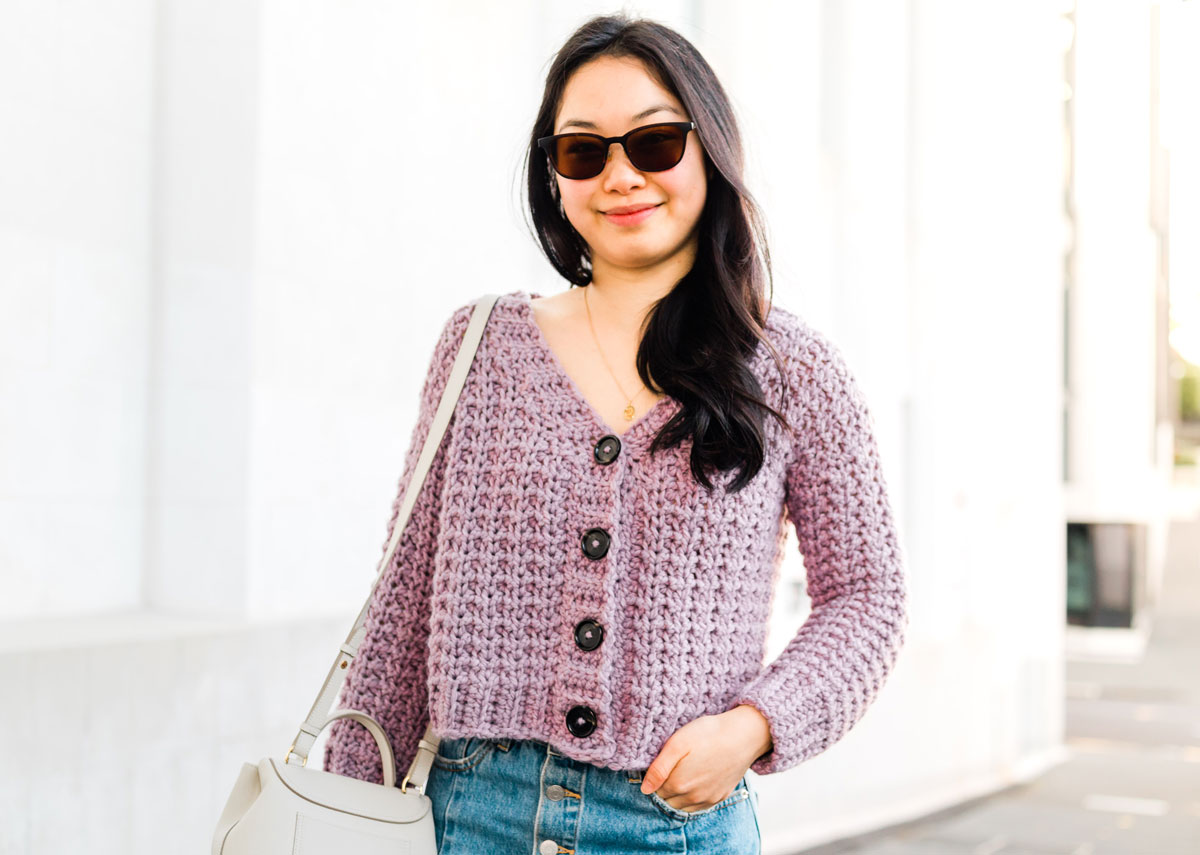
This post may contain affiliate links, view our disclosure policy for details.
Thank you to WeCrochet for providing the yarn for this free crochet cardigan pattern! As always all thoughts and opinions are 100% my own 🙂
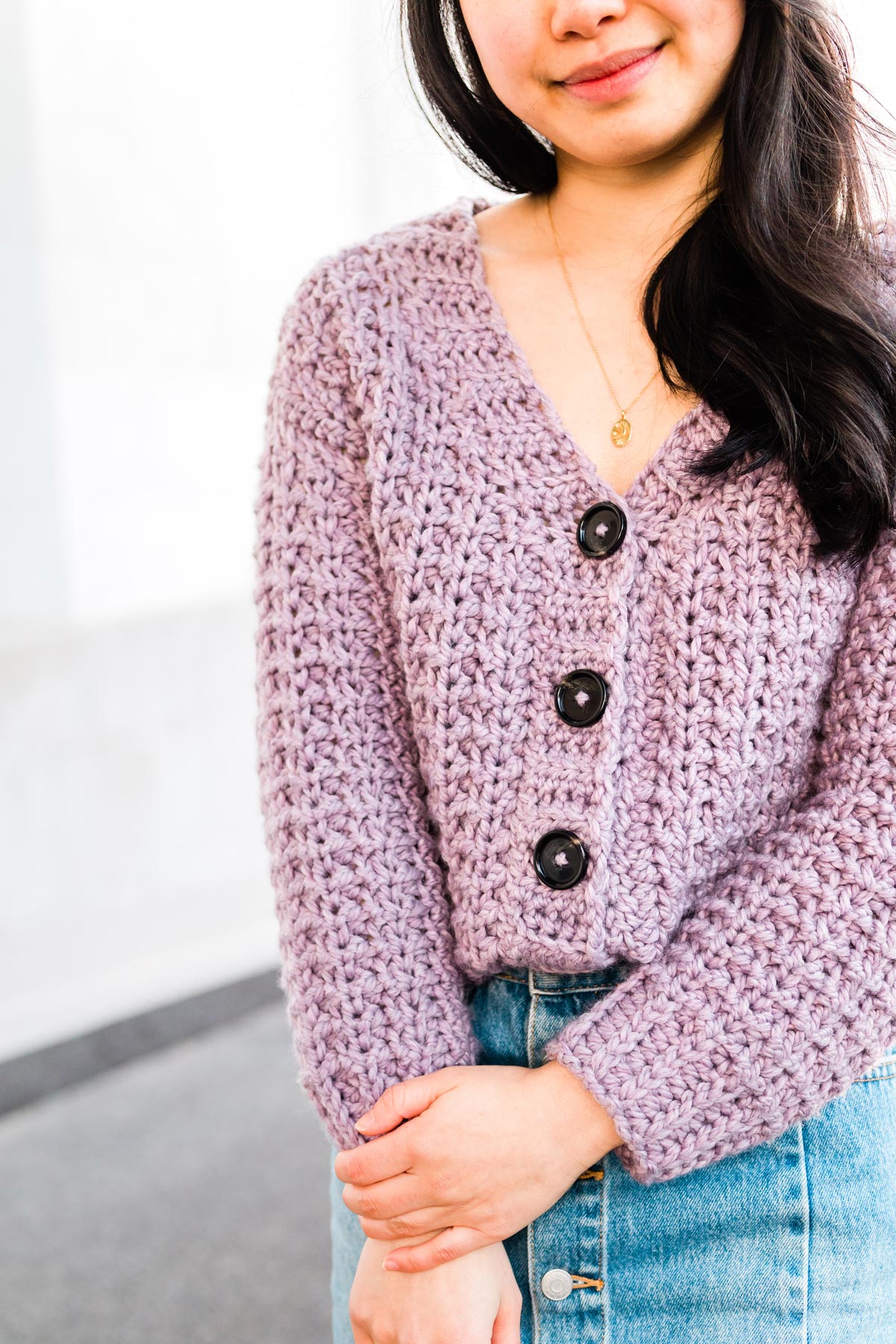
Chunky, cozy and textured – what more could you want from a crochet cardigan? Add in buttons and you’ve got my dream sweater! It’s been over a year since my first button project (Check out the Aria Cardigan for a lightweight v-neck cardi!) and I thought it was time for another button cardi, they’re just so incredibly versatile!
Waffle Stitch Texture
The majority of the Twilight Cardi is worked in front loop and back loop half double crochets which gives this incredible almost waffle-like texture without extra bulk of the traditional waffle stitch! I discovered this stitch combo through trial and error but please let me know if it has an official name 🙂
Crocheting this cardi is a breeze just make sure you can clearly ‘spot’ your front and back loops! The most important tip is to rotate your work so that the tops of your stitches (the ‘v’ shapes) are facing you. Remember, that the strand of yarn closet to you is the front loop and the one furthest away is the back loop.
Working into the front and back loops as opposed to both strands at the same time is really one of the best techniques to create garments that are comfortable and wearable. Drape is the key to have that certain ‘je ne sais quoi’ to get your projects looking handmade but modern.
(Some other patterns that use with front and back loop crochet with very different textures are the Chunky Bomber Cardigan, Sagebrush Tank Top and Amalfi Sweater!)
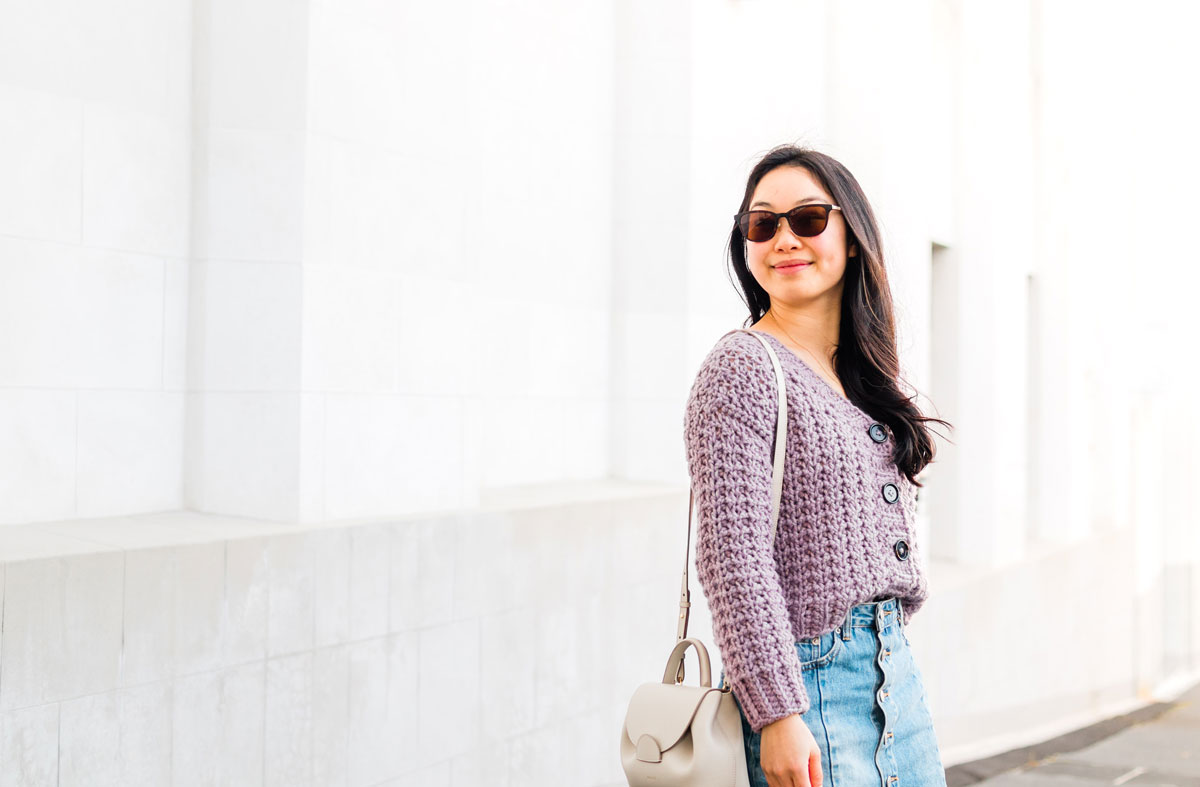
Cardigan Construction
The construction of this v-neck cardi is very simple as the body is worked entirely in one piece – including the hemline ribbing! The Twilight Cardigan is worked lengthways which means that our foundation runs the length of the cardigan instead of side to side. The best thing about this construction is that you don’t need to fasten off at all during the body portion which means less ends to weave in yay!
The sleeves are also worked lengthways and then we’ll crochet the neckline button hole ribbing separately and sew it into place. Add on the buttons and you’re all done!
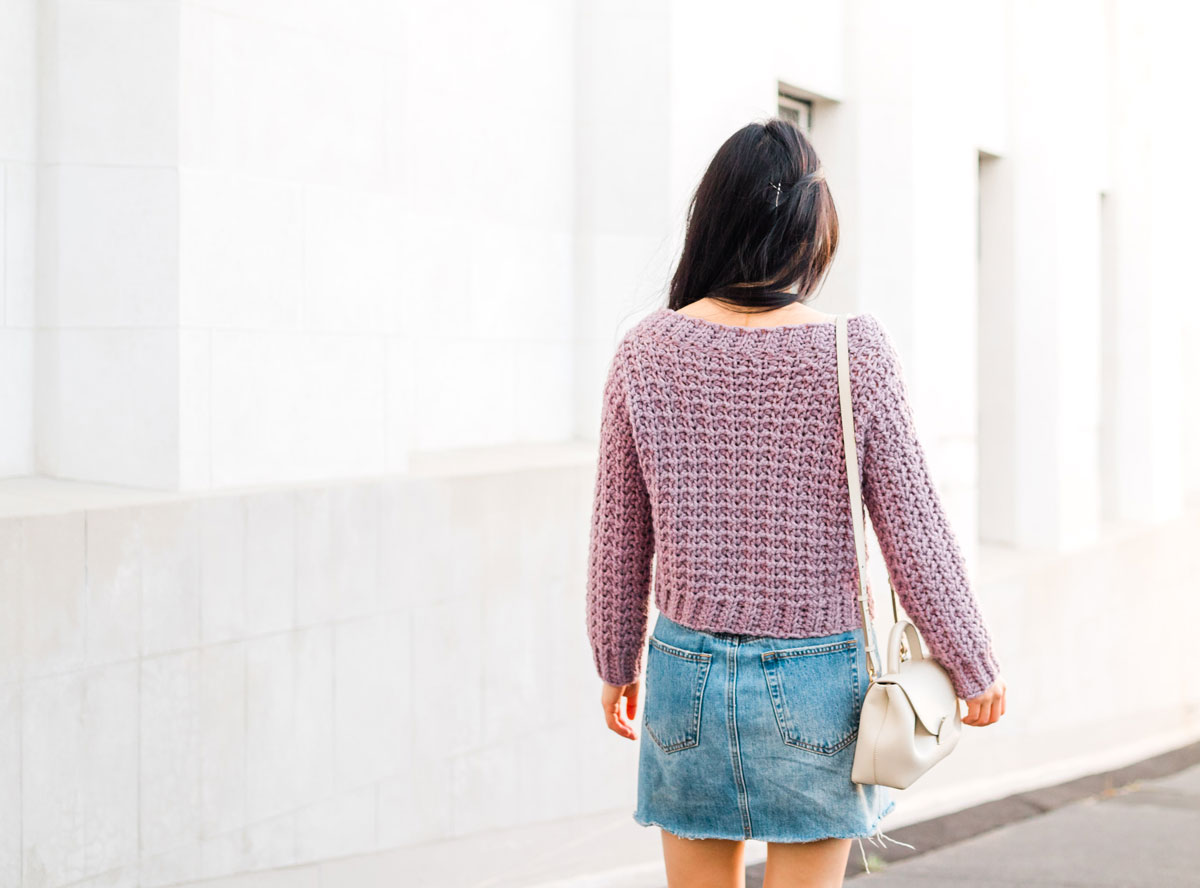
How do I print the pattern?
If you love to crochet offline or on the go, you can always find a low-cost printable PDF version of all my free patterns. This nicely-formatted pdf contains 20 pages, a link to the video tutorial and photo tutorial. The pictures are also separated from the written pattern so you can save on ink! You’ll also find the PDF to be a really valuable upgrade, if you prefer to view the ad-free version on your phone, tablet or laptop.
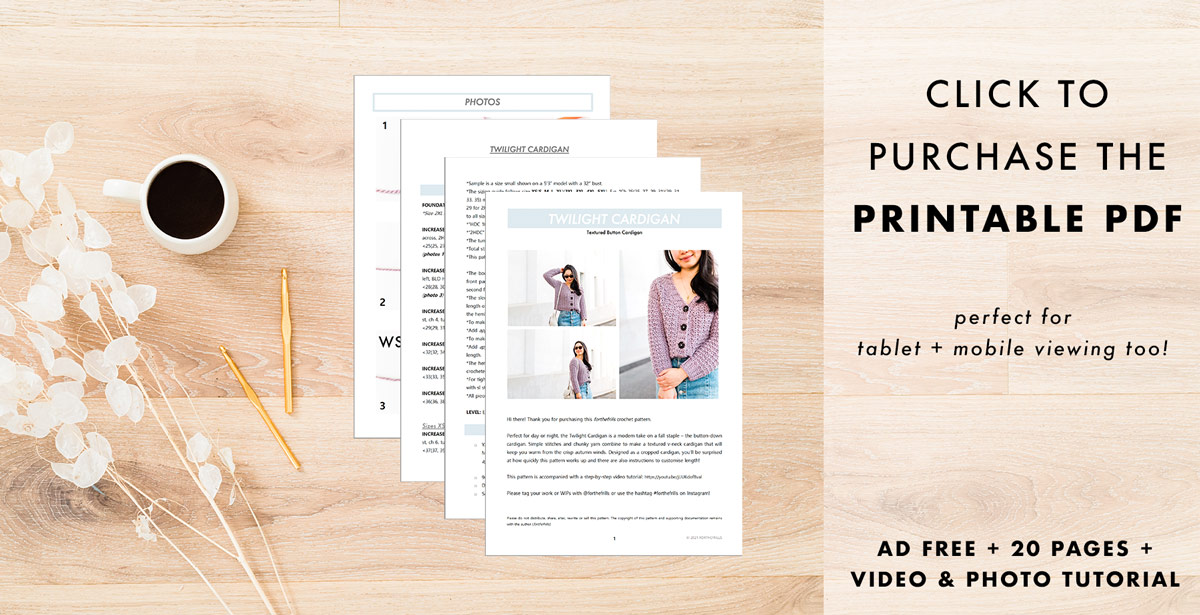
How to crochet button holes
There are lots of different ways to add button hole ribbing to crochet sweaters but the most commonly used methods are 1. Crocheting ribbing directly onto your cardigan (I used this method for the Aria Button Cardigan) or 2. Crocheting the ribbing separately and sewing it on (As seen with the Pompeii Cardigan).
For the Twilight Cardigan, the ribbing is crocheted separately and then sewn onto the neckline. We’ll create the button holes by chaining 1, skipping 1 st and then crocheting into the next stitch. It’s as simple as that! The 1 chain + 1 skipped stitch combo might seem really small but trust me! Buttonholes stretch out very easily and quickly so it’s best to have a very snug fit with your button and button hole.
The reason why I like to crochet neckline ribbing in a different piece is simple – gauge! I find that when crochet ribbing separately and then sewing it on after results in ribbing that stays flat.
Often when crocheting the ribbing directly onto a garment it can be difficult to get the gauge to perfectly match. Crocheting directly onto the main piece works well with blankets, beanies or even hemlines. However, since necklines tend to have curves – a round neck or sloping edges like a v-neck, the weight of the cardi pulls down on the opening which can cause the neckline to ruffle.
If you’ve seen some of my patterns, you’ll know that I try to minimise the sewing whenever I can. However, there are times where the extra care is worth it and the Twilight Cardigan is definitely one of those patterns 🙂
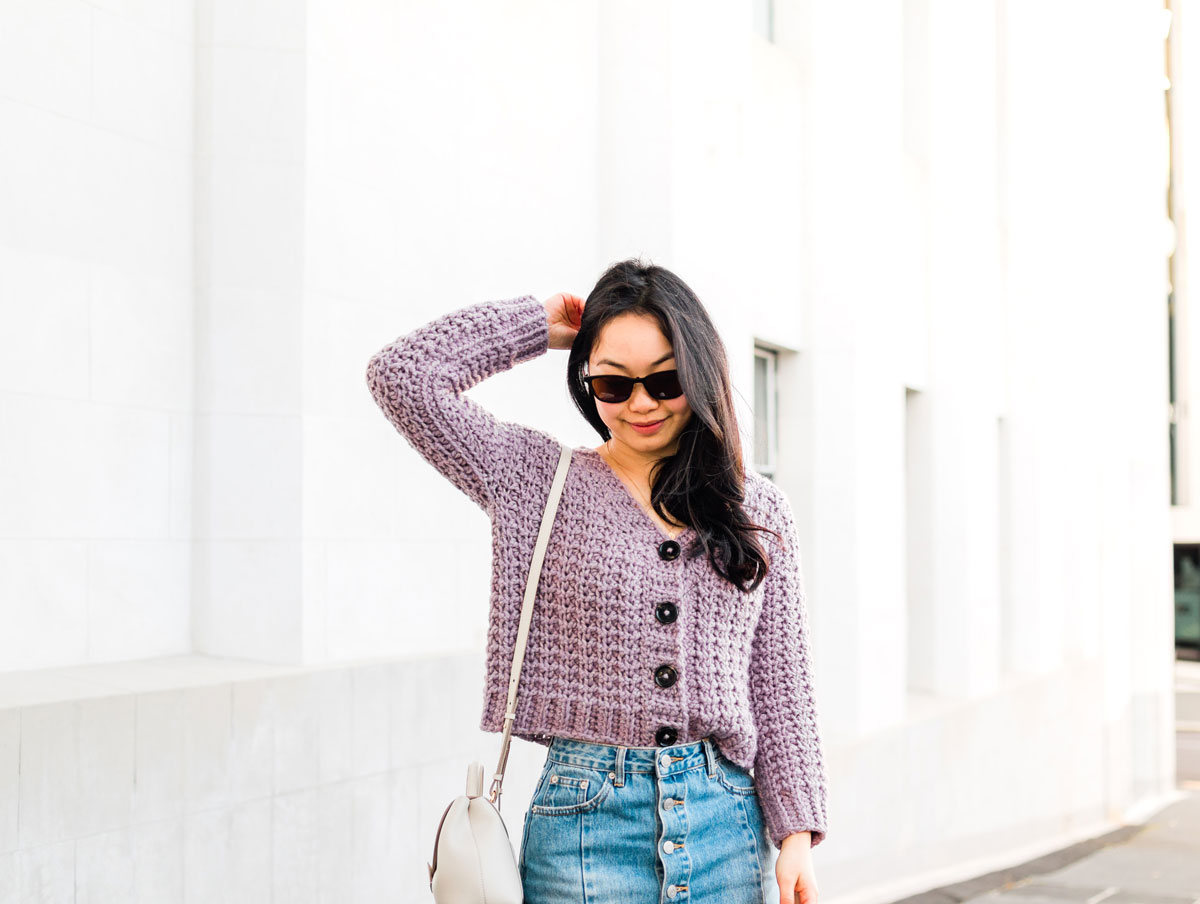
Design Inspiration
I’ve been dreaming of a waffle cardigan since I first started designing – which was over 2 years ago in 2019! It’s crazy how time flies! However, the thing that held me back time and time again was that crochet waffle stitch is very bulky and stiff. I’ve learnt now that if the stitch doesn’t have drape you’ll feel like you’re wearing a cardboard box haha.
I’m constantly swatching different types of yarn and stitch combinations to find options that work well for garments. I happened to try this combo of front and back loop half double crochets and I fell I love with the texture.
At first, I thought of making a long crochet cardigan with pockets (If you’d like a long version let me know!) but since I recently released the Palermo Cardigan I thought it’d be fun to do a quick and chunky project. You’ll be surprised at how quickly this project works up!
Looking for more free crochet patterns?
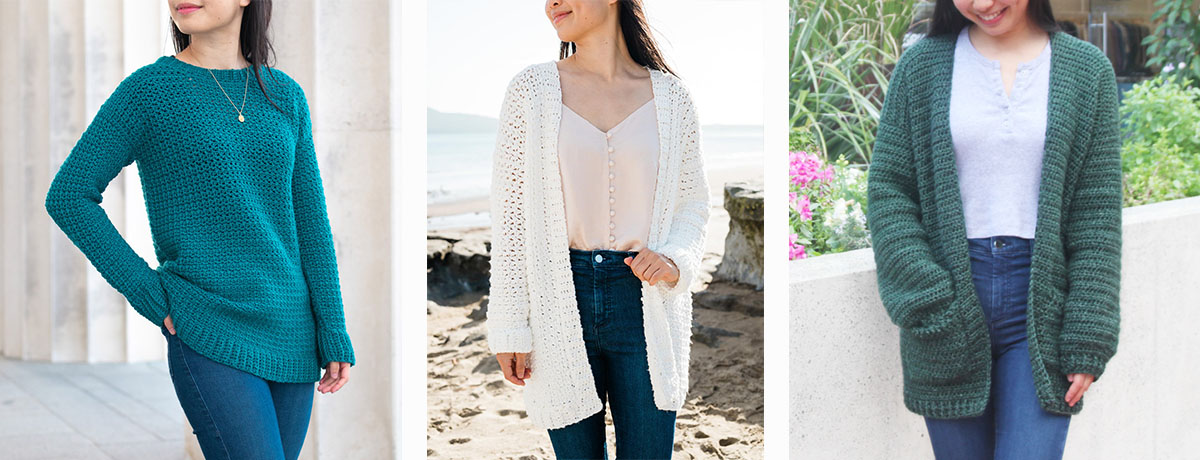
1. Weekend Snuggle Sweater / 2. In The Clouds Cardigan / 3. Briar Pocket Cardigan
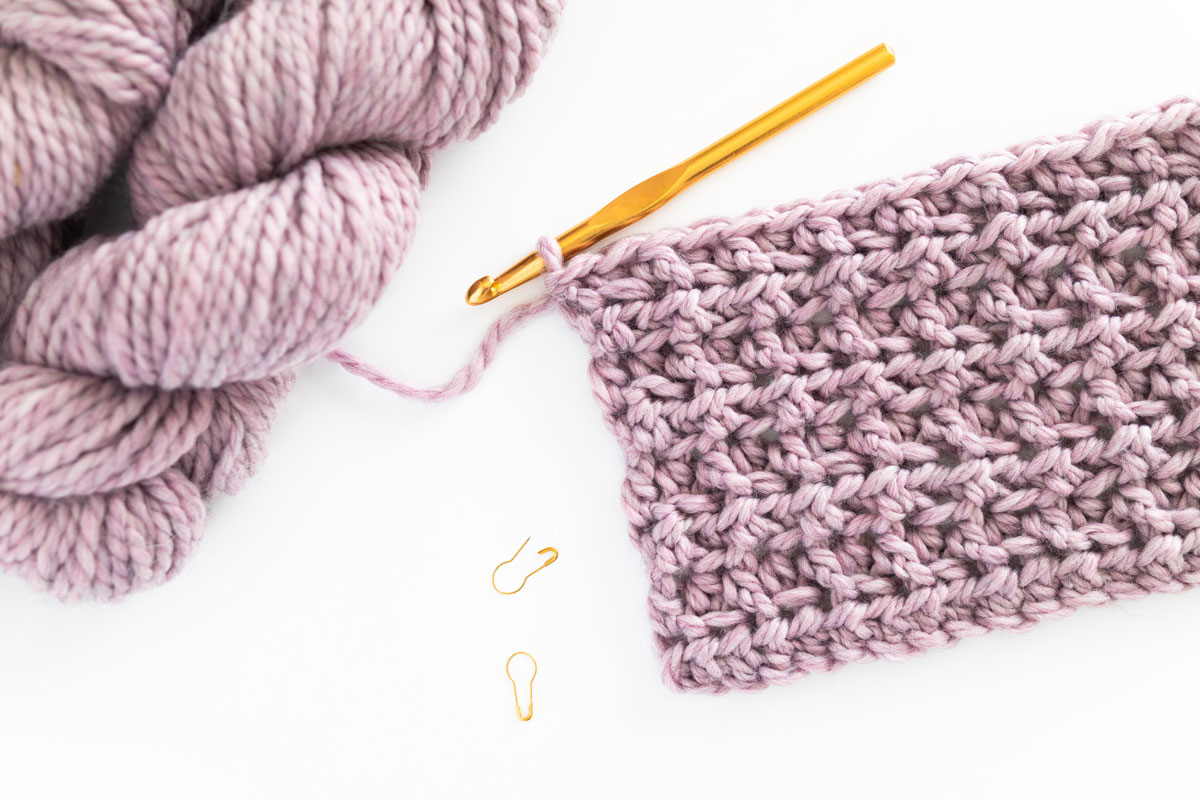
Yarn
The Twilight Cardigan uses WeCrochet Biggo yarn and I think I’ve discovered a new favourite yarn! Biggo is made from a mix 50% merino and 50% nylon creating an incredibly soft and fluffy feeling yarn that also has incredible stitch definition. Although the yardage per 100g might seem standard for a bulky yarn there is an incredible light airiness that makes you feel like you’re wearing a marshmallow!
This chunky cropped cardigan is worked up in the shade Magnolia Heather which is lovely dusty lilac with grey undertones. It’s more muted than a traditional pastel purple which makes it so much more wearable in everyday life. Biggo comes in 15 different shades and they’re all heathered which means they have softer more muted tones than solid colours.
*Update: Unfortunately WeCrochet Biggo has been discontinued 🙁 Some chunky yarn substitutes are –
- WeCrochet Mighty Stitch Bulky (100% acrylic, solid colours)
- Lion Brand Scarfie (Acrylic-wool blend, variegated colourways)
- WeCrochet Billow (Pima cotton yarn, thin and thick texture)
Video Tutorial
Would you love to crochet a button cardigan but don’t know where to start? The video tutorial takes you through the entire pattern demonstrating front and back loop stitches, v-neck shaping, as well as the assembly and button hole ribbing!
I love to see your finished projects! Use #forthefrills and tag me on Instagram @forthefrills for a chance to be featured 🙂
Click to pin me for later!
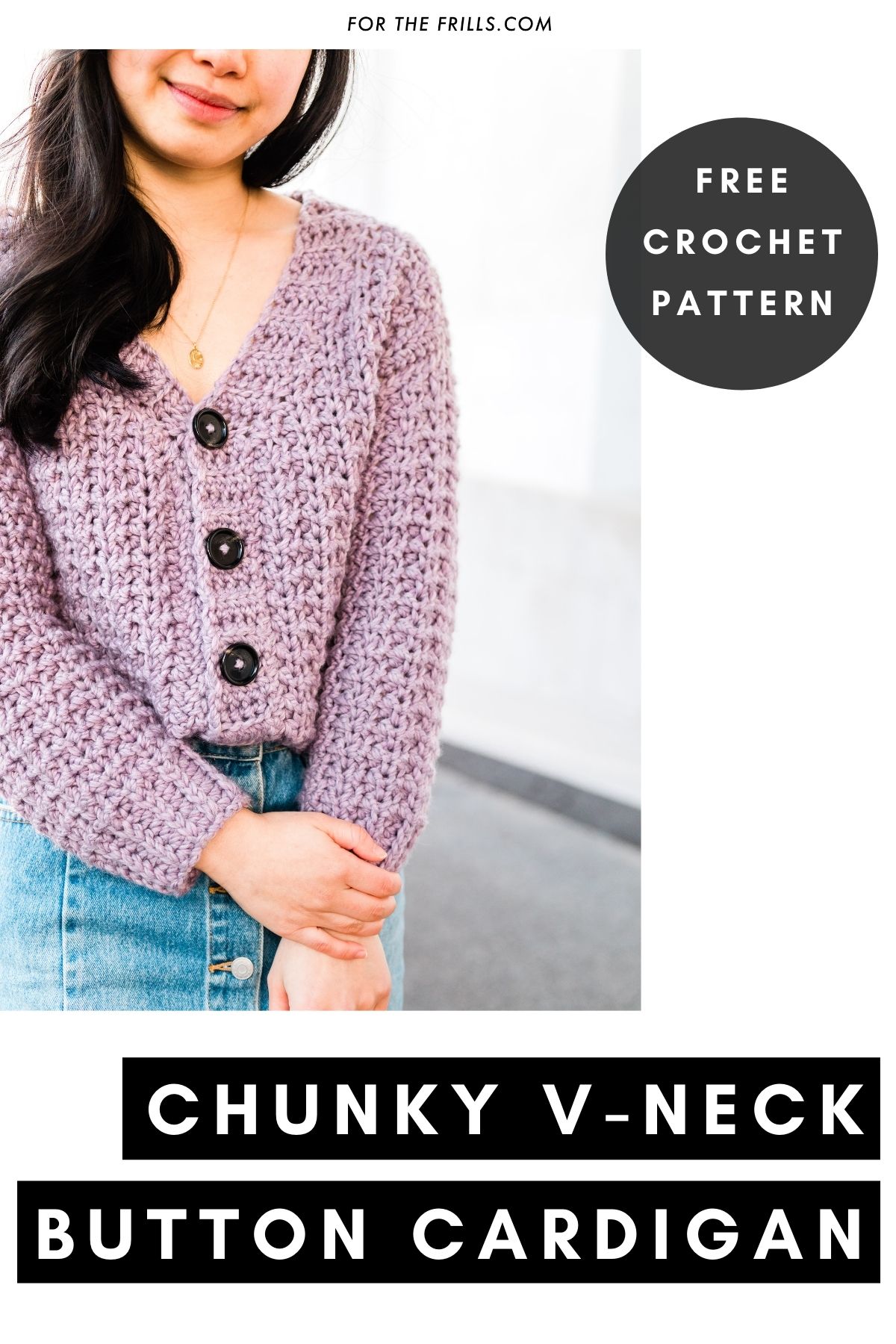
I love to see your finished projects! Use #forthefrills and tag me on Instagram @forthefrills for a chance to be featured
Add the Twilight Cardigan to your Ravelry queue!
Purchase the ad-free, printable pdf version of the Twilight Cardigan!
Find the step-by-step video tutorial here!
Twilight Cardigan Summary:
A chunky, textured crochet cardigan with a boxy fit, cropped length and v-neck button opening. This pattern uses slip stitches, single crochets, half double crochets in back and front loops to create a waffle like texture.
NOTES:
*Sample is a size small shown on a 5’3” model with a 32” bust.
*The sizing guide follows size XS(S, M, L, XL)(2XL, 3XL, 4XL, 5XL). E.g. “Ch 25(25, 27, 29, 31)(29, 31, 33, 35) means Ch 25 for XS, Ch 25 for Small, Ch 27 for Medium, Ch 29 for Large, Ch 31 for XL, Ch 29 for 2XL, Ch 31 for 3XL, Ch 33 for 4XL and Ch 35 for 5XL.” If there is only one number, it applies to all sizes.
*"HDC 10" means HDC into the next 10 stitches.
*"2HDC" means place 2 HDC into the same stitch.
*The turning chain, ch 1 does NOT count as a stitch. Otherwise, ch 1 does count as a stitch.
*Total stitches are indicated between < >.
*This pattern uses US crochet terms.
*The body is worked entirely in one piece beginning with crocheting the v-neck increase + first front panel, an opening for the 1st sleeve, the back panel, an opening for the 2nd sleeve and the second front panel + v-neck decrease.
*The sleeves, back and front panels are worked from side to side. The foundation chain runs the length of the sleeve and the length of the sweater from the point of the v-neck to the bottom of the hemline ribbing.
*To make your cardigan shorter/longer, remove/add chains in multiples of 2.
*Add approx. 17(20, 22, 24, 26)(27, 30, 32, 35)g of yarn for every additional 2.5cm / 1” of body length.
*To make your sleeves shorter/longer, remove/add chains in multiples of 2.
*Add approx. 12(12, 14, 15, 16)(18, 19, 20, 21)g of yarn for every additional 2.5cm / 1” of sleeve length.
*The hemline ribbing is crocheted in one piece with the main body panel. The neckline ribbing is crocheted separately and sewn onto the cardigan.
*For tighter waist ribbing on the body panel, you can replace all BLO SCs with BLO sl sts and SCs with sl sts. This will make the waist width approx. 30-40% smaller than the back width.
*All pieces are sewn together with the RS on the inside and the WS facing outwards.
LEVEL: Easy+
Materials
Yarn – WeCrochet Biggo – Chunky/Bulky (5), 100m/100g, 110yds/3.5oz, 50% Superwash Merino Wool + 50% Nylon, Magnolia Heather
approx. 505(550, 630, 725, 805)(890, 990, 1110, 1360)g
9mm (US M/N) Crochet Hook
Darning Needle
Scissors
4 buttons (3cm / 1.25” diameter)
4 Stitch markers/Safety pins
Stitches & Abbreviations
Ch = Chain
Sl st = Slip Stitch
SC = Single Crochet
HDC = Half Double Crochet
FLO = Front Loop
BLO = Back Loop
St(s) = Stitch(es)
Rep = Repeat
Sk = Skip
RS = Right Side
WS = Wrong Side
Measurements cm:
To fit Bust: 71(81, 91, 101, 112)(122, 132, 142, 152)
Back Width: 42(47, 51, 57, 63)(67, 72, 78, 85)
Armhole: 15(15, 16, 18, 19)(21, 22, 24, 25)
Sleeve length: 38(38, 40, 42, 42)(44, 44, 46, 46)
Length: 40(40, 42, 44, 46)(48, 50, 52, 54)
Measurements inches:
To fit Bust: 28(32, 36, 40, 44)(48, 52, 56, 60)
Back Width: 16.5(18.5, 20, 22.5, 25)(26.5, 28.5, 31, 33.5)
Armhole: 6(6, 6.5, 7, 7.5)(8, 8.5, 9, 9.5)
Sleeve length: 15(15, 16, 16.5, 16.5)(17, 17, 18, 18)
Length: 16(16, 16.5, 17, 18)(19, 19.5, 20.5, 21)
GAUGE: 10cm/4” square = 10 stitches wide x 6.5 rows tall in Textured HDC Stitch Pattern.
Textured HDC Stitch Pattern
FOUNDATION CHAIN: Ch an even number of stitches.
ROW 1: Working into the back bumps of the chs, HDC in 2nd ch from hook, HDC across, turn.
ROW 2: Ch 1, *FLO HDC, BLO HDC; rep from * across, HDC in last st, turn.
ROW 3: Ch 1, *BLO HDC, FLO HDC; rep from * across, HDC in last st, turn.
Repeat ROWS 2 – 3 until you reach your desired length.
Twilight Crochet Cardigan Pattern
Body Panel
First Front Panel
FOUNDATION CHAIN: Ch 25(25, 27, 29, 31)(29, 31, 33, 35).
*Size 2XL is supposed to have 29 chains as it has more increase rows than Size XL (31 chains).
INCREASE ROW 1 (RS): Working into the back bumps of the chs, SC in 2nd ch from hook, SC 4, HDC across, 2HDC in last ch, ch 4, turn.
<25(25, 27, 29, 31)(29, 31, 33, 35)sts + 4 chs>
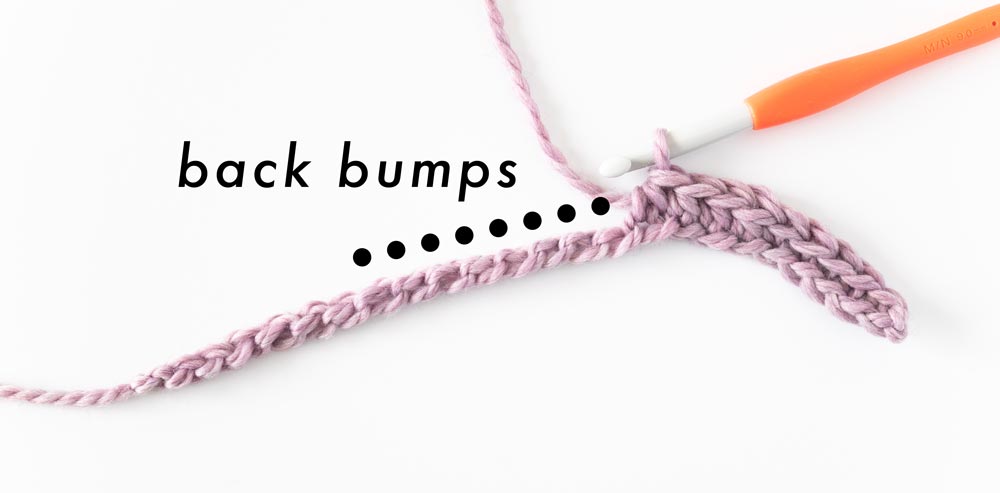
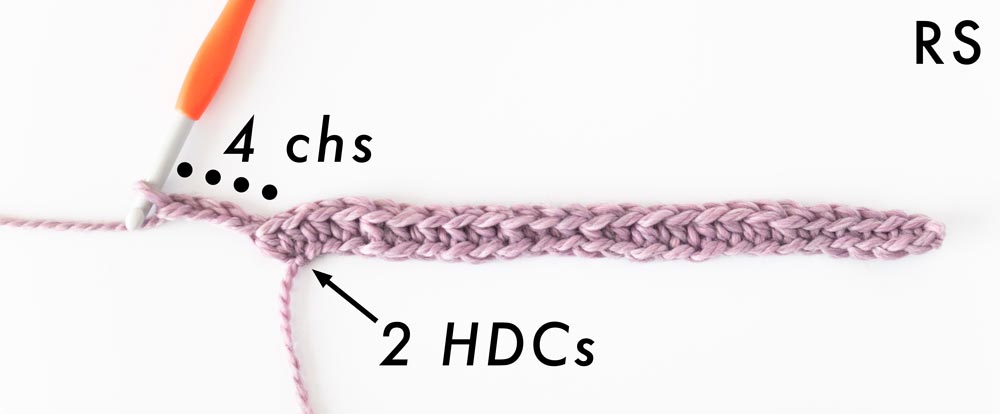
INCREASE ROW 2: HDC in 2nd ch from hook, HDC 2, *FLO HDC, BLO HDC; rep from * until 5 sts left, BLO HDC 4, HDC in last st, turn.
<28(28, 30, 32, 34)(32, 34, 36, 38)>

INCREASE ROW 3: Ch 1, BLO SC 5, *FLO HDC, BLO HDC; rep from * across, [FLO HDC, HDC] in last st, ch 4, turn.
<29(29, 31, 33, 35)(33, 35, 37, 39) + 4 chs>
INCREASE ROW 4: As Row 2.
<32(32, 34, 36, 38)(36, 38, 40, 42)>
INCREASE ROW 5: As Row 3.
<33(33, 35, 37, 39)(37, 39, 41, 43) + 4 chs)>
INCREASE ROW 6: As Row 2.
<36(36, 38, 40, 42)(40, 42, 44, 46)>
Sizes XS(S, M, L, XL) only
INCREASE ROW 7: Ch 1, BLO SC 5, *FLO HDC, BLO HDC; rep from * across, [FLO HDC, HDC] in last st, ch 6, turn.
<37(37, 39, 41, 43) + 6 chs>
INCREASE ROW 8: HDC in 2nd ch from hook, HDC 4, *FLO HDC, BLO HDC; rep from * until 5 sts left, BLO HDC 4, HDC in last st, turn.
<42(42, 44, 46, 48)>
Do not fasten off! Proceed to ‘BASE BODY PANEL ROWS’.
Sizes (2XL, 3XL, 4XL, 5XL) only
INCREASE ROW 7: As Row 3.
<(41, 43, 45, 47) + 4 chs>
INCREASE ROW 8: As Row 2.
<(44, 46, 48, 50)>
INCREASE ROW 9: Ch 1, BLO SC 5, *FLO HDC, BLO HDC; rep from * across, [FLO HDC, HDC] in last st, ch 6, turn.
<(45, 47, 49, 51)+ 6 chs>
INCREASE ROW 10: HDC in 2nd ch from hook, HDC 4, *FLO HDC, BLO HDC; rep from * until 5 sts left, BLO HDC 4, HDC in last st, turn.
<(50, 52, 54, 56)>
Do not fasten off! Proceed to ‘BASE BODY PANEL ROWS’.
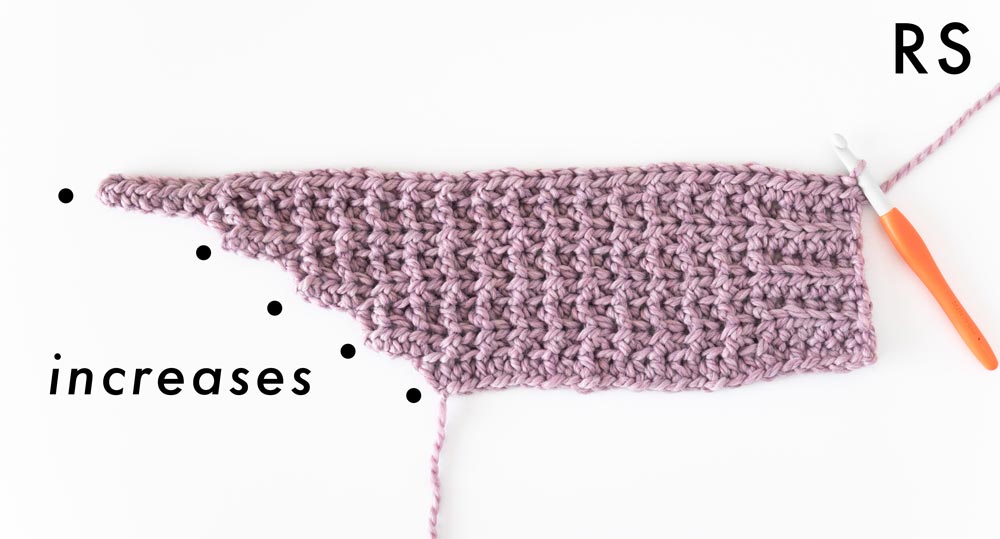
Base Body Panel Rows
BASE BODY ROW 1: Ch 1, BLO SC 5, *FLO HDC, BLO HDC; rep from * across, HDC in last st, turn.
<42(42, 44, 46, 48)(50, 52, 54, 56)>
BASE BODY ROW 2: Ch 1, *BLO HDC, FLO HDC; rep from * until 6 sts left, BLO HDC 5, HDC in last st, turn.
<42(42, 44, 46, 48)(50, 52, 54, 56)>
Repeat BASE BODY ROWS 1 – 2 until ROW 12(14, 16, 18, 20)(20, 22, 24, 26).
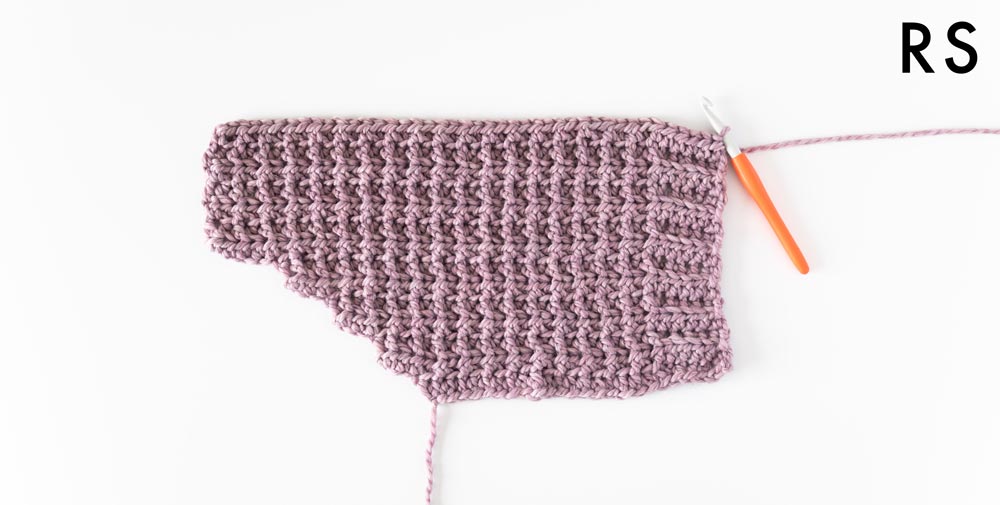
We’ve finished the FIRST FRONT PANEL. Do not fasten off! We’ll now crochet the ‘BACK PANEL’.
Back Panel
BACK PANEL ROW 1: Ch 1, BLO SC 5, *FLO HDC, BLO HDC; rep from * until 17(17, 19, 19, 21)(23, 23, 25, 27) sts left, HDC in next st, ch 17(17, 19, 19, 21)(23, 23, 25, 27), turn.
<26(26, 26, 28, 28)(28, 30, 30, 30)sts + 17(17, 19, 19, 21)(23, 23, 25, 27)chs>
*The chs form the 1st sleeve armhole opening.
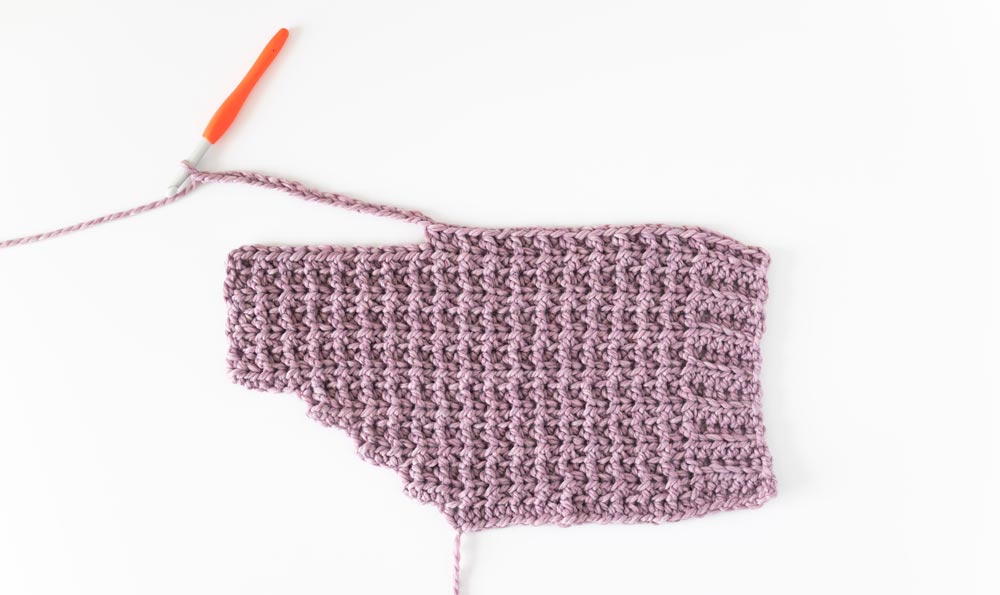
BACK PANEL ROW 2: HDC in 2nd ch from hook, HDC in each ch, *BLO HDC, FLO HDC; rep from * until 6 sts left, BLO HDC 5, HDC in last st, turn.
<42(42, 44, 46, 48)(50, 52, 54, 56)>
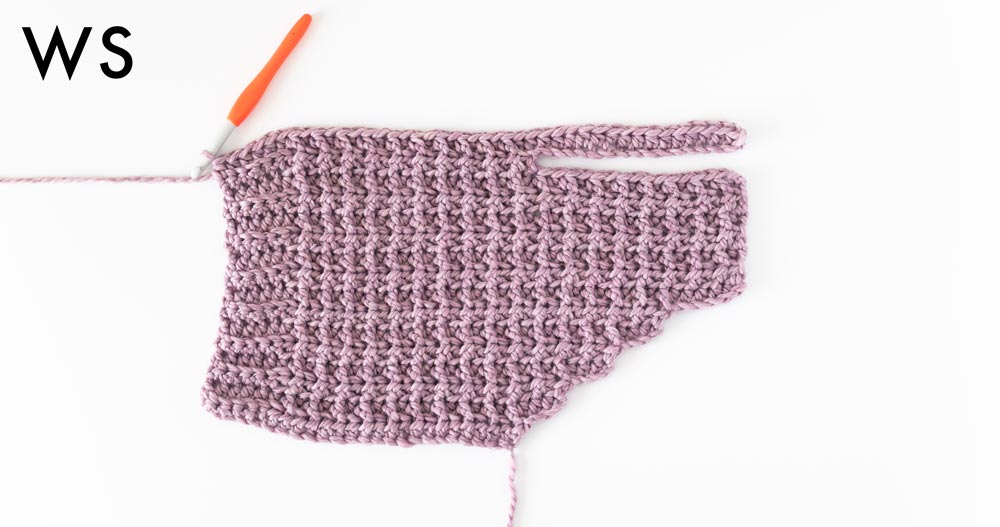
Repeat BASE BODY ROWS 1 – 2 until ROW 28(32, 34, 38, 42)(44, 48, 52, 56).<42(42, 44, 46, 48)(50, 52, 54, 56)>
Total Rows: <40(46, 50, 56, 62)(64, 70, 76, 82)>
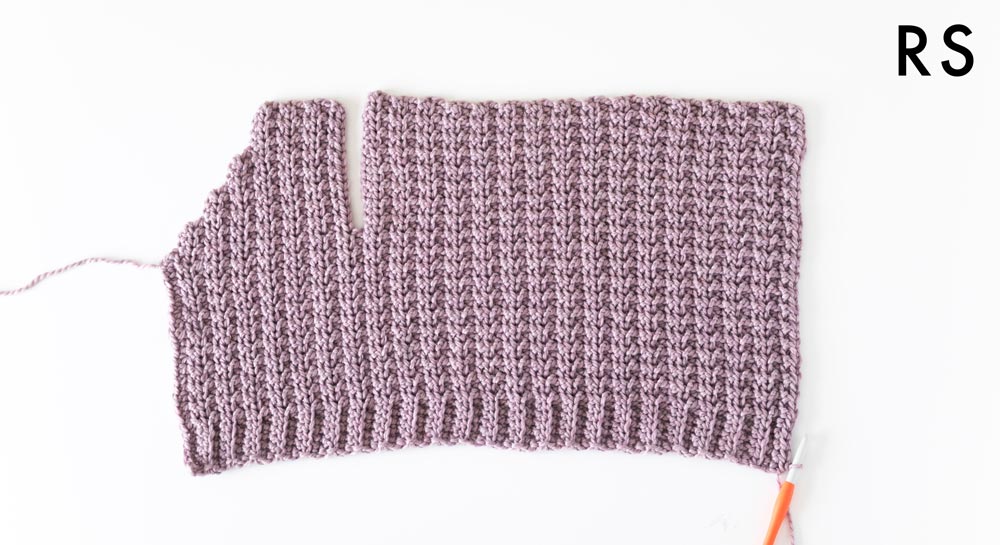
We’ve finished the BACK PANEL. Do not fasten off! We’ll now crochet the 'SECOND FRONT PANEL'.
Second Front Panel
ROW 1: As Back Panel Row 1.
*The chs form the 2nd sleeve armhole opening.
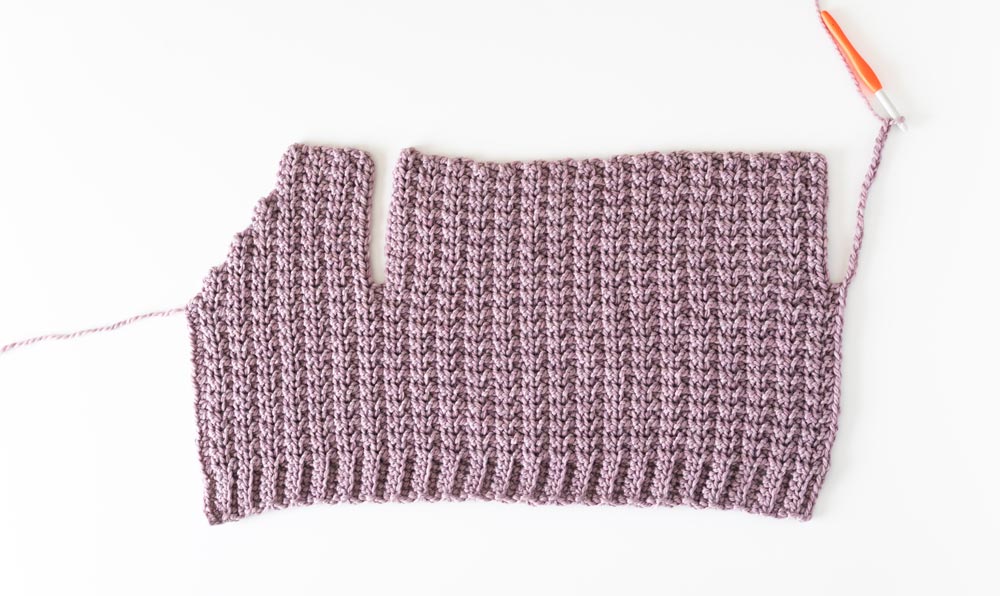
ROW 2: As Back Panel Row 2.
Total Rows: <42(48, 52, 58, 64)(66, 72, 78, 84)>
Repeat BASE BODY ROWS 1 – 2 until ROW 6(8, 10, 12, 14)(12, 14, 16, 18).
Total Rows: <46(54, 60, 68, 76)(76, 84, 92, 100)>
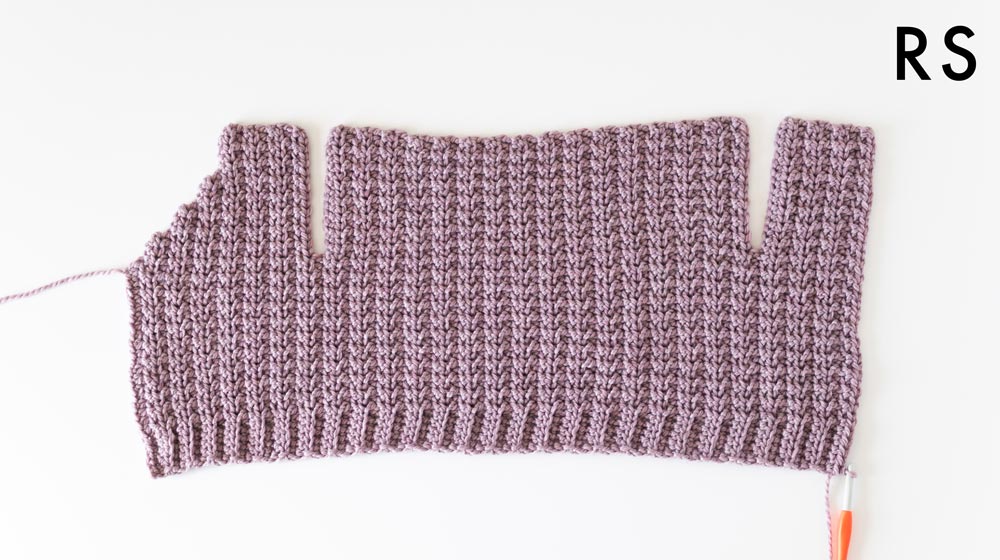
DECREASE ROW 1: Ch 1, BLO SC 5, FLO HDC, *BLO HDC, FLO HDC; rep from * until 6 sts left, HDC in next st, turn.
<37(37, 39, 41, 43)(45, 47, 49, 51)>
Total Rows: <47(55, 61, 69, 77)(77, 85, 93, 101)>
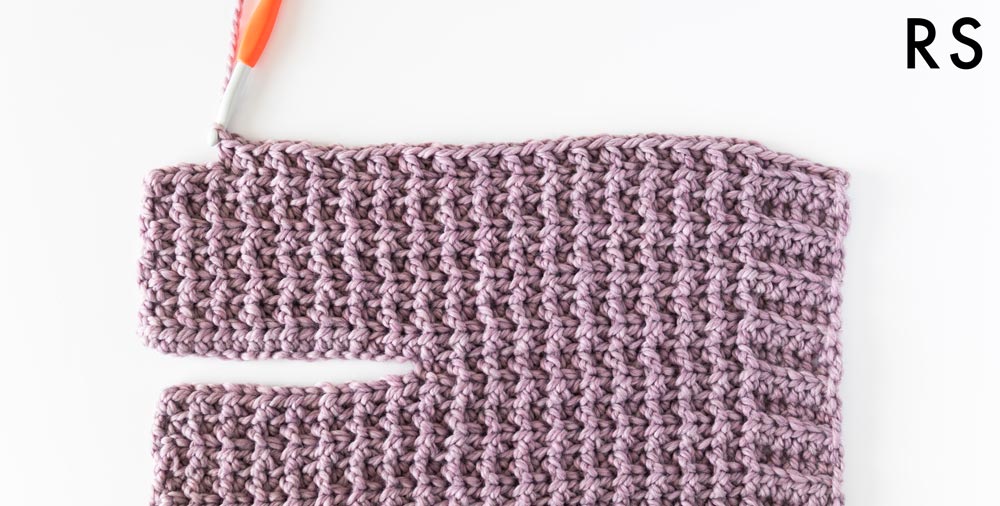
DECREASE ROW 2: Ch 1, sk 1st st, *BLO HDC, FLO HDC; rep from * until 6 sts left, BLO HDC 5, HDC in last st, turn.
<36(36, 38, 40, 42)(44, 46, 48, 50)>
Total Rows: <48(56, 62, 70, 78)(78, 86, 94, 102)>
*If you have trouble spotting the beginning/end of the row, place a SM in the 1st BLO HDC to make it easier to spot.
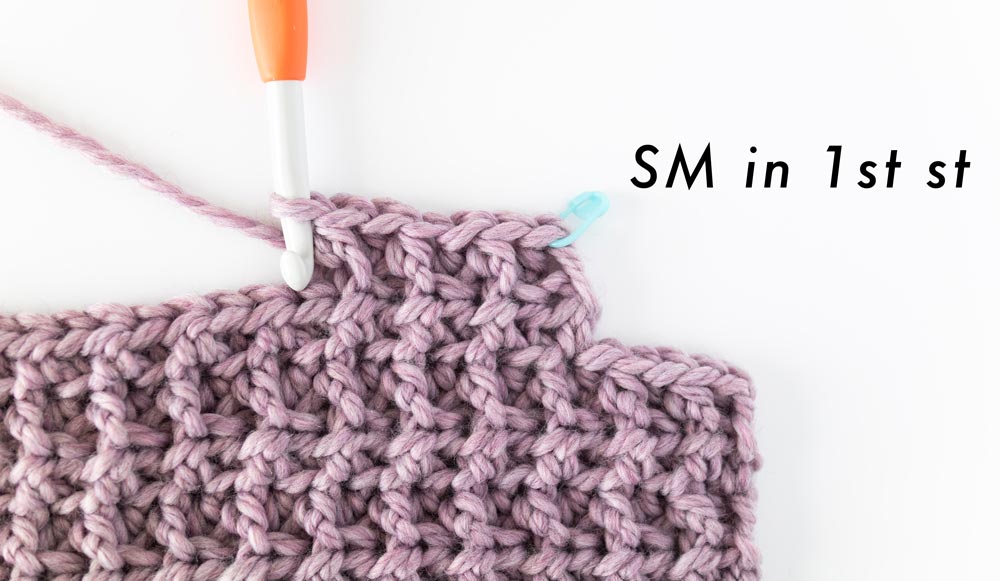
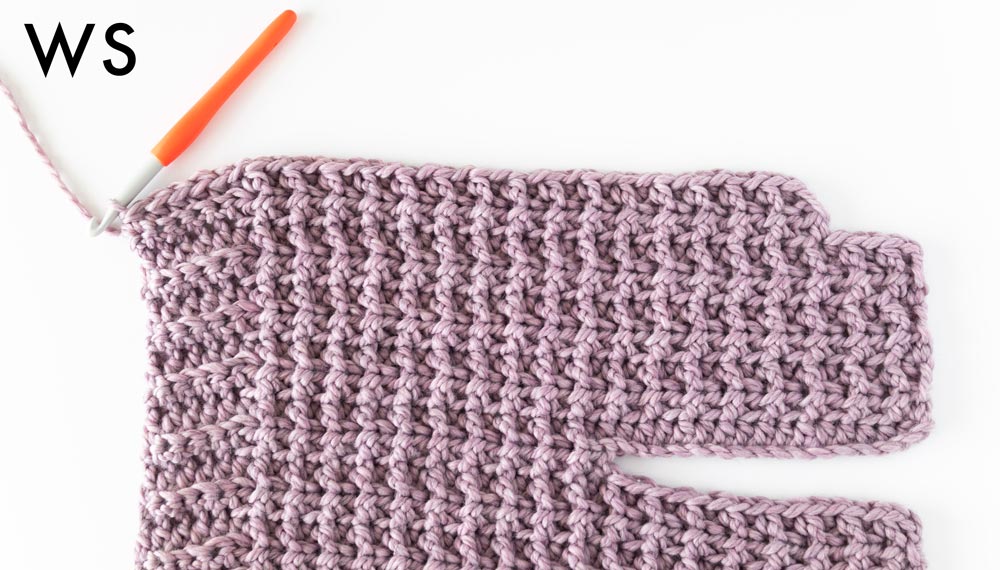
DECREASE ROW 3: Ch 1, BLO SC 5, FLO HDC, *BLO HDC, FLO HDC; rep from * until 4 sts left, HDC in next st, turn.
<33(33, 35, 37, 39)(41, 43, 45, 47)>
DECREASE ROW 4: As Decrease Row 2.
<32(32, 34, 36, 38)(40, 42, 44, 46)>
DECREASE ROW 5: As Decrease Row 3.
<29(29, 31, 33, 35)(37, 39, 41, 43)>
DECREASE ROW 6: As Decrease Row 2.
<28(28, 30, 32, 34)(36, 38, 40, 42)>
DECREASE ROW 7: As Decrease Row 3.
<25(25, 27, 29, 31)(33, 35, 37, 39)>
Total Rows: <53(61, 67, 75, 83)(83, 91, 99, 107)>
Sizes XS(S, M, L, XL) – Fasten off.
Sizes (2XL, 3XL, 4XL, 5XL) only
DECREASE ROW 8: As Decrease Row 2.
<(32, 34, 36, 38)>
Total Rows: <(84, 92, 100, 108)>
DECREASE ROW 9: As Decrease Row 3.
<(29, 31, 33, 35)>
Total Rows: <(85, 93, 101, 109)>
Fasten off.

Sleeves
(make 2)
FOUNDATION CHAIN: Ch 41(41, 43, 45, 45)(47, 47, 49, 49).
ROW 1 (RS): Working into the back bumps of the chs, HDC in 2nd ch from hook, HDC in each ch across, turn.
<40(40, 42, 44, 44)(46, 46, 48, 48)>
ROW 2: Ch 1, *BLO HDC, FLO HDC; rep from *until 6 sts left, BLO sl st 5, sl st in last st, turn.
<40(40, 42, 44, 44)(46, 46, 48, 48)>

ROW 3: Ch 1, BLO HDC 7, *FLO HDC, BLO HDC; rep from * across, HDC in last st, turn.
<40(40, 42, 44, 44)(46, 46, 48, 48)>
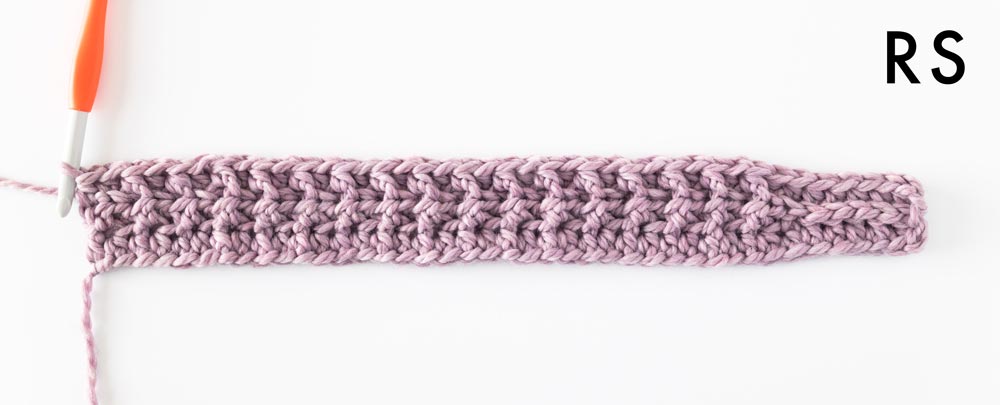
Repeat ROWS 2 – 3 until ROW 19(19, 21, 23, 25)(27, 29, 31, 33).
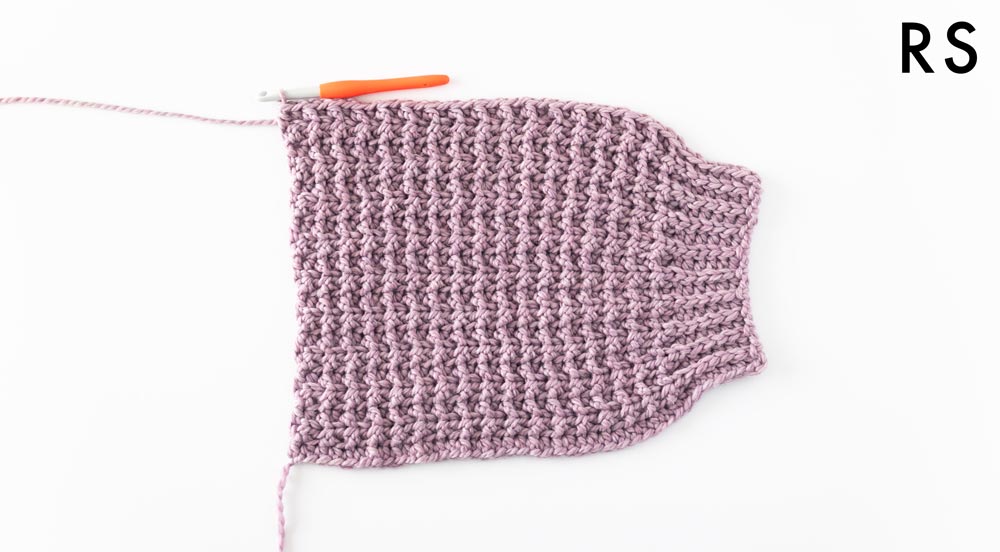
Fasten off.
Fold sleeve in half lengthways. Whip stitch the edges of the sleeve together.

Assembly
Lay front panels on top of the back panel.
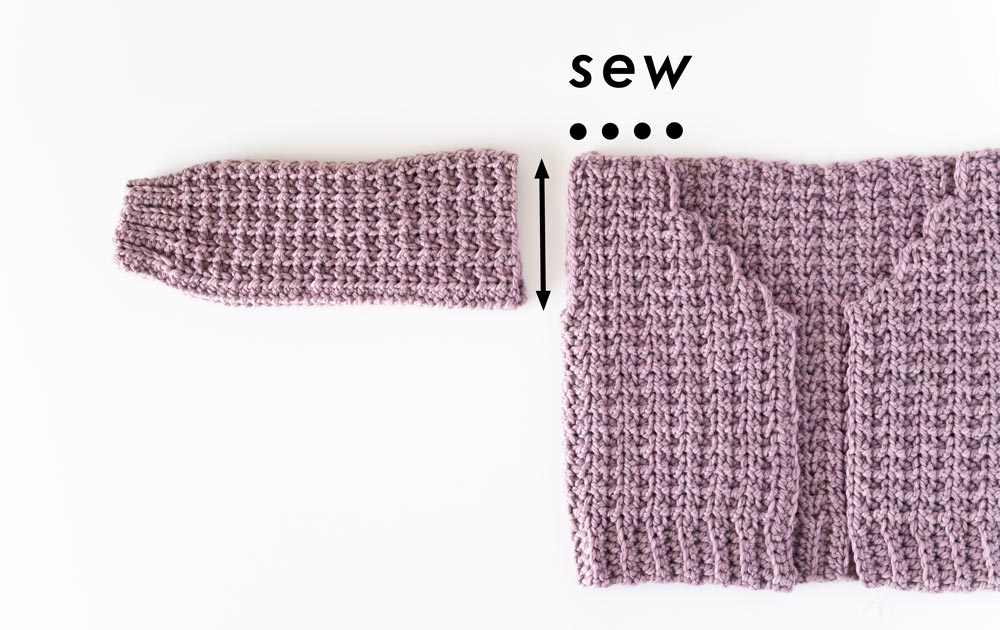
Whip stitch shoulder seams together.
Whip stitch top of sleeves to arm holes.
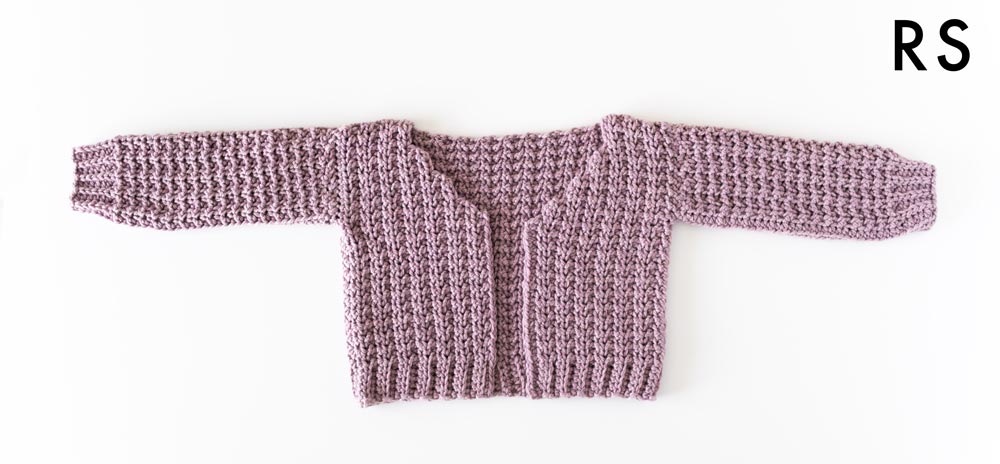
Neckline Ribbing
With the RS facing you, space out the 4 buttons evenly along the opening edge of the neckline.
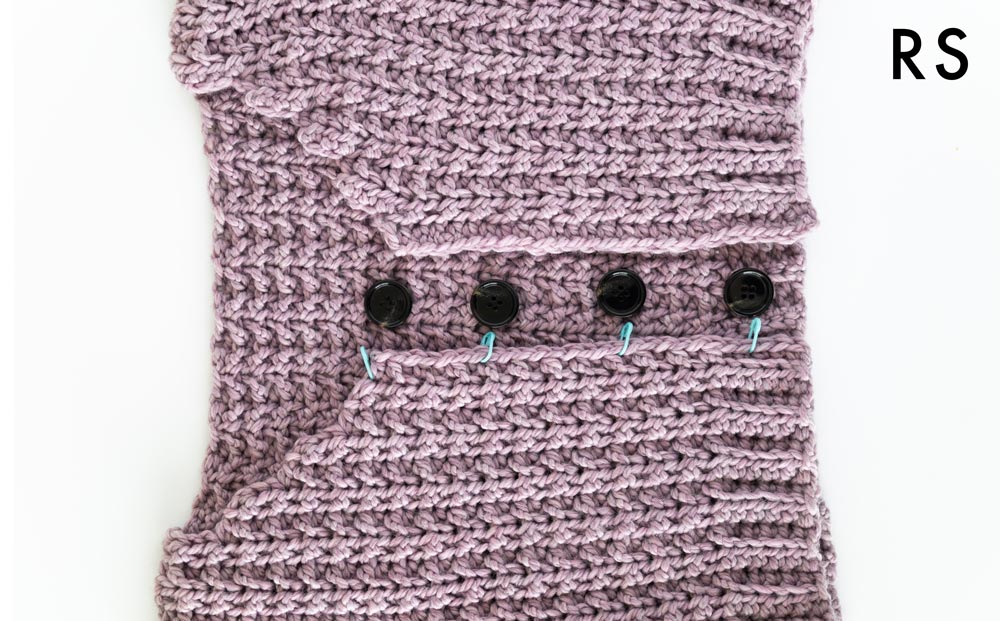
Line up a SM with the bottom of each button and place SM in corresponding st.
FOUNDATION CHAIN: Ch 6.
ROW 1: Working into the back bumps of the chs, SC in 2nd ch from hook, SC in each ch across, turn.
<5>
ROW 2: Ch 1, BLO HDC 4, HDC in last st, turn.
ROW 3: Ch 1, BLO SC 4, SC in last st, turn.
Repeat ROWS 2 – 3 until the height of the ribbing reaches the 1st SM.
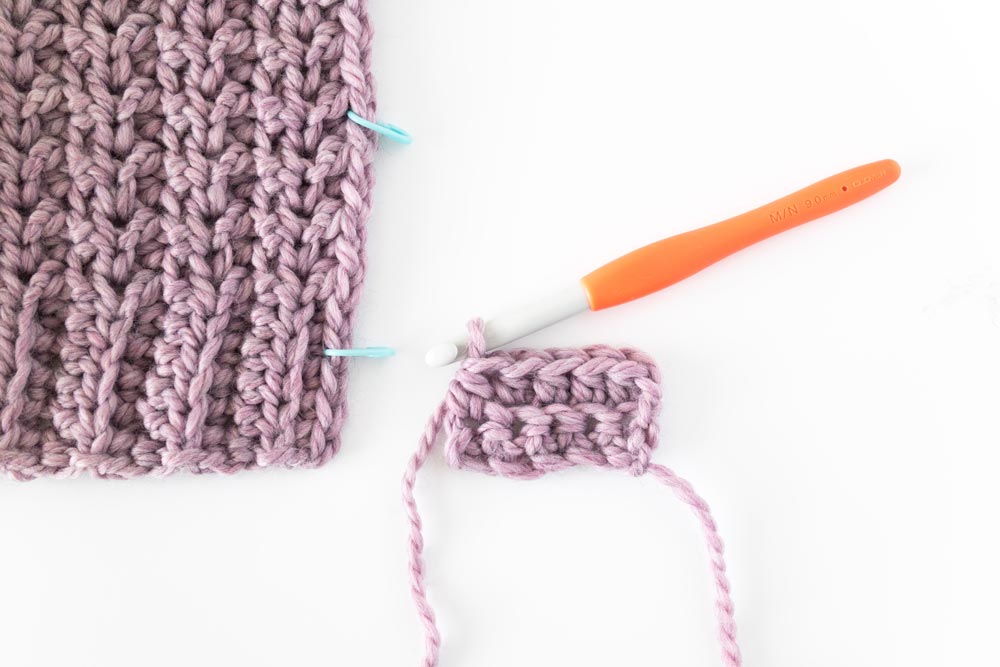
*A SC row always follows an HDC row and vice versa.
e.g. If you’ve just crocheted a row of HDCs repeat the SC BUTTONHOLE ROW.
If you’ve just crocheted a row of SCs repeat the HDC BUTTONHOLE ROW.
SC BUTTONHOLE ROW: Ch 1, BLO SC 2, ch 1, sk 1 st, BLO SC, SC in last st, turn.
HDC BUTTONHOLE ROW: Ch 1, BLO HDC 2, ch 1, sk 1 st, BLO HDC, HDC in last st, turn.
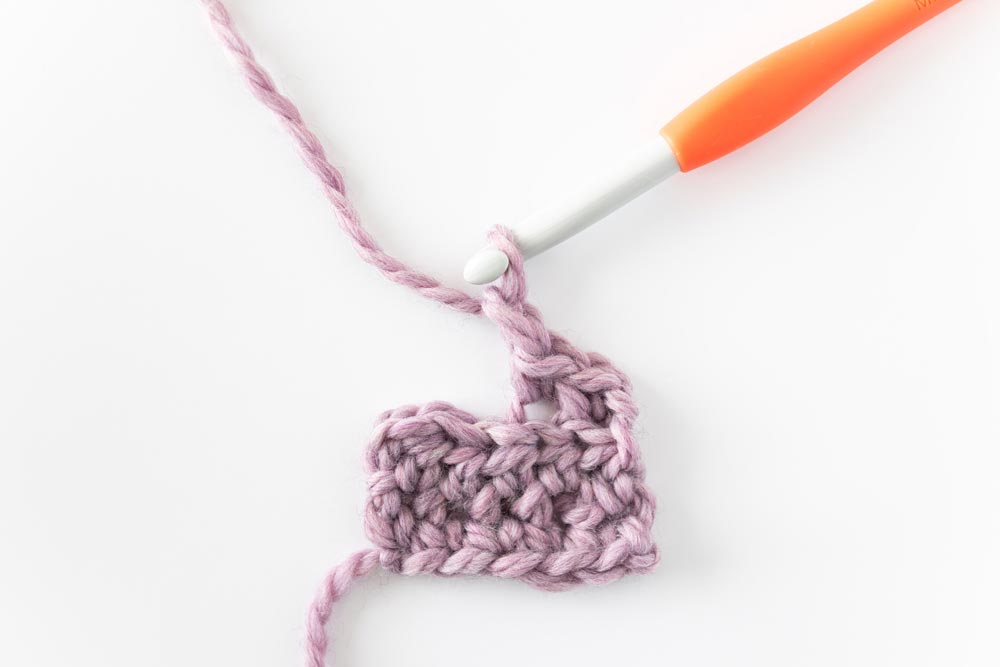
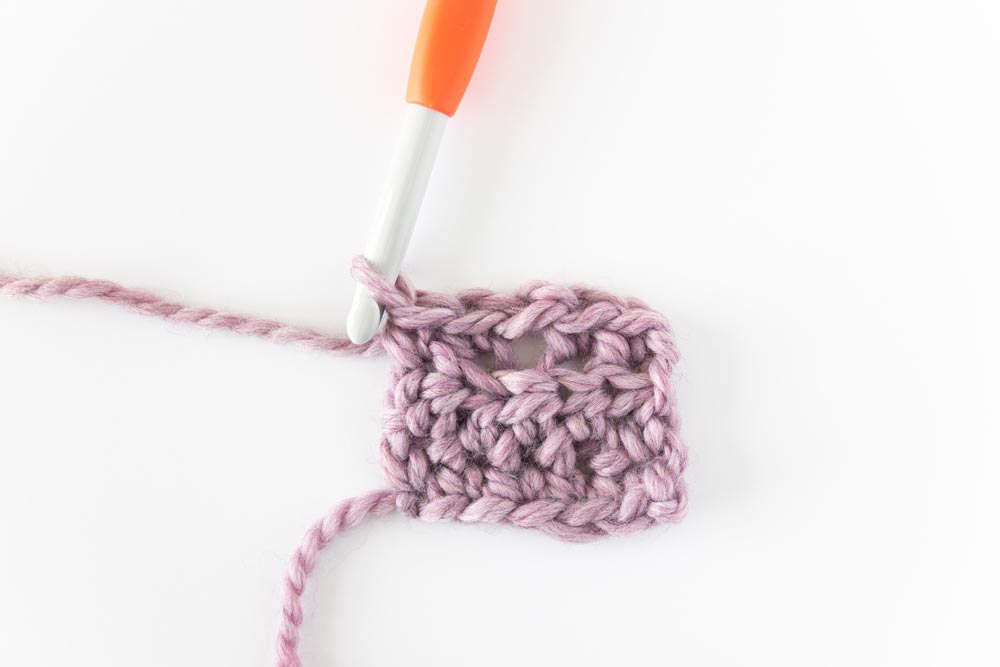
*Make sure your buttons fit in the button holes. If the hole is too small, enlarge the gap by *ch 2, sk 2 sts*.

Continue to alternate between ROWS 2 – 3 until the height of ribbing reaches the next SM, then repeat a BUTTONHOLE row.
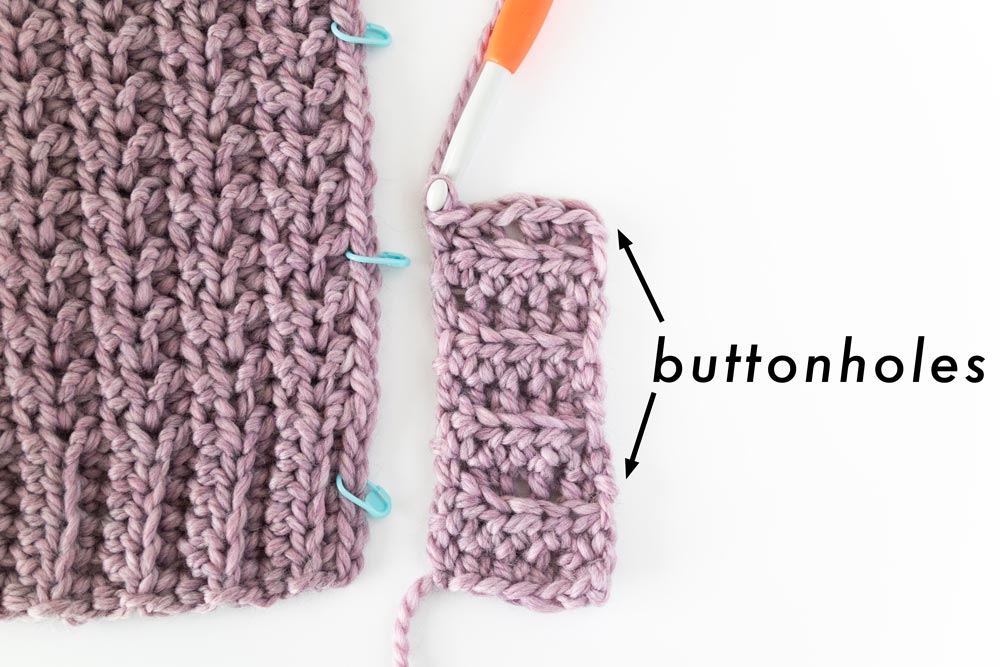
Once you’ve crocheted all 4 buttonholes, continue to alternate between ROWS 2 – 3 until the ribbing measures the length of the entire neckline.
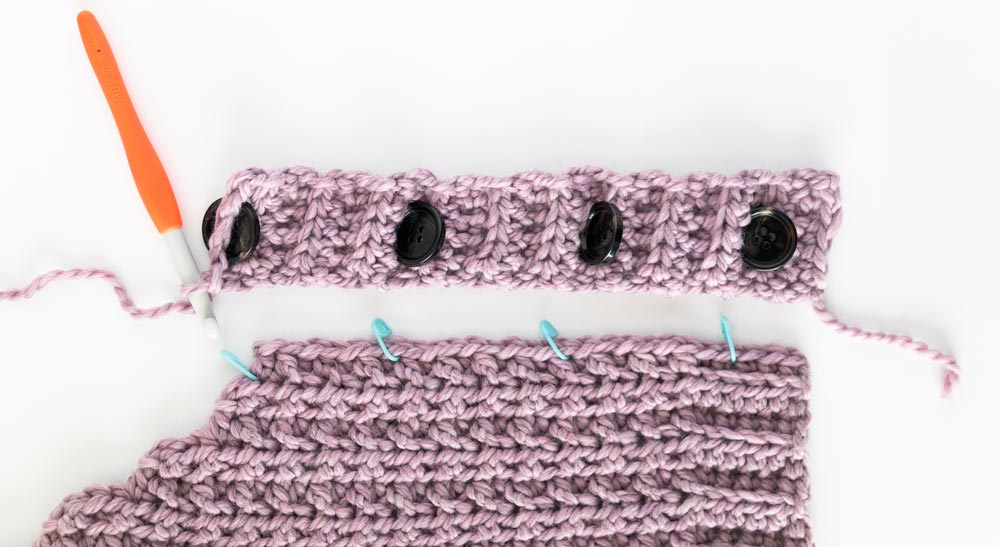
Fasten off.
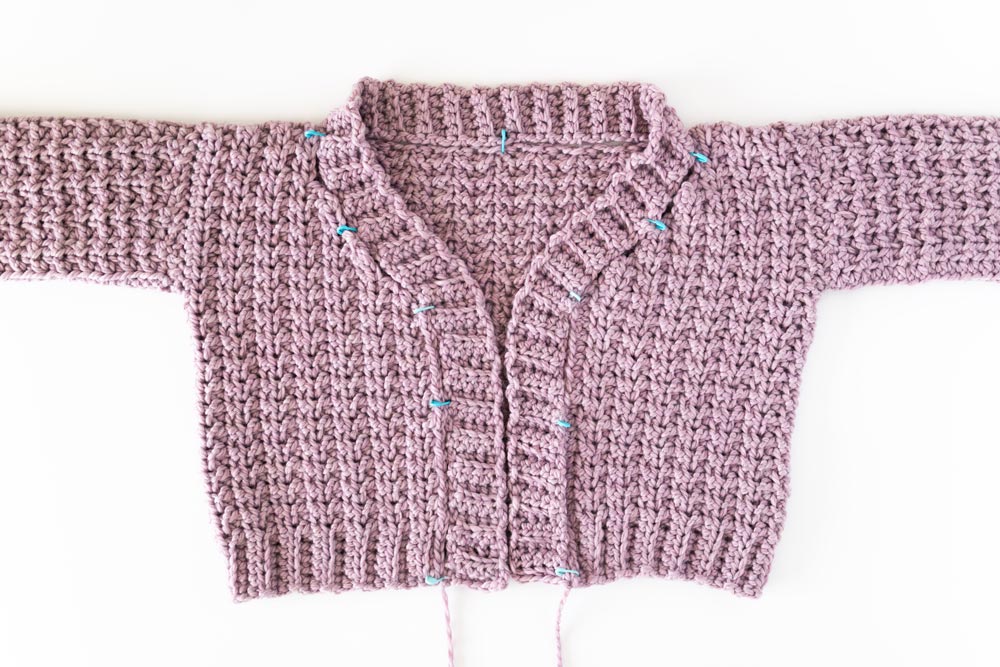
Pin ribbing along neckline and whip stitch ribbing to neckline.
Pin ribbing along neckline and whip stitch ribbing to neckline. Along the v-neck increase and decreases, take care to sew over the corners/bumps.
*After you’ve sewn over the corners they should resemble small ‘bumps’.
*The bumps will not be visible when wearing the cardigan nor should you be able to feel them.
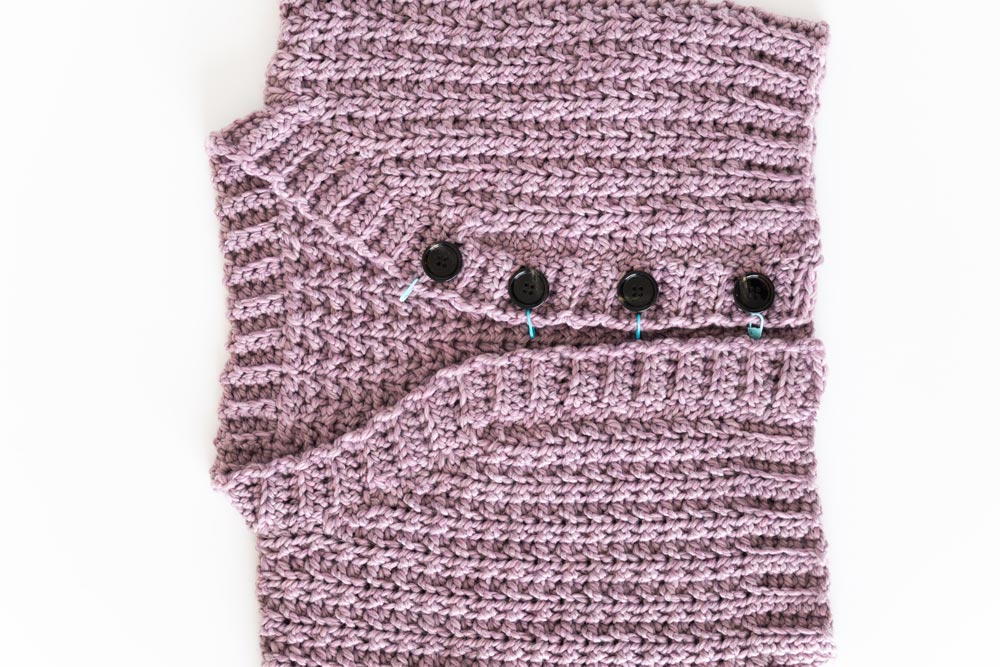
Sew buttons on the other side of the neckline opening, taking care to match buttons to button holes.
*You can use SMs to mark the button placement.
*If the neckline is ruffling – you’ve placed the button too close together and if the neckline is pulling/puckering – you’ve placed the buttons too far apart.
Finishing
Weave in all of your ends. Steam block your cardigan.
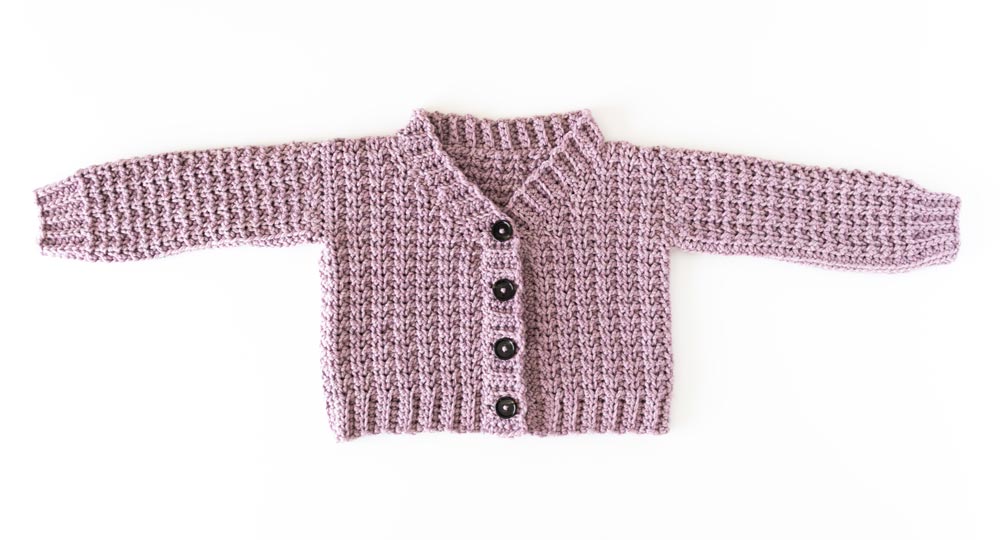
Voilà! You’ve finished your Chunky Button Cardigan 🙂
Ready for your next crochet project?


Can you tell me about how many rolls of the Biggo yarn I would need to make a medium sweater and a large sweater. Please. I figure it would take 6 but want to make sure I dont buy to much but worst not enough. I love your video's. So easy to follow!
Thank you for sharing your Art.
Patricia
Beautiful cardigan I plan to make. I'm having a dilemma. I'm unsure whether I will have enough yarn and the colour is discontinued. What would you recommend? Do all ribbing another colour and sew it on? Or work pattern and do centre ribbing in another color? Any other ideas?
Hi! I have a beautiful worsted weight yarn I'd like to use for this project. Do you think this would work with worsted weight yarn, and if it would impact the sizing can you give advice on how to allow for this?
Thank you!
Hi Grace!
I sent you a message on Instagram a little while ago. I love your patterns and the items I've made from them are my new favourites. I was wondering how you felt about items made from your patterns being sold.
Thank you!
Is there a reason to make the button side of the neckline ribbing first? I haven’t found the buttons I want yet but would like to start making the ribbing.
Hello from Poland! I just love this project and can't wait to get it started. I bought the yarn I loved and wanted to start but got stuck at the beginning. My yarn is light (3) kind and I use my 3.5 mm hook for it. According to the gauge I will need twice as many stitches in width which is clear for me but how to make it twice as long as the project shows? Should I repeat every row too? Can you please maybe help me?
I was working on this is size M and managed to make the entire body piece, but the rows just don't add up! With one front panel so much bigger than the other I had a huge overlap between the two sides so no room for the collar ribbing and total number of rows wasn't match what was listed. Will unfortunately have to find a new pattern, this one seemed adorable and easy enough but just didn't add up!
I have just finished the Base Body Panel Rows (after the first front panel) and I am REALLY confused! The front looks huge - WAY too wide. I followed your pattern exactly as written - "until row 17" for size medium. When starting the Back Panel, it starts on an odd row, which conflicts with ending the previous section on an odd row. In looking forward to the second front panel, you show 10 rows (size medium) before decreasing, so I'm wondering if that's what should also be for the base body panel rows? HELP!!! Please respond! Thanks!
Hey, I've also been working through the pattern (almost finished, size s though) and I found the same issue - when moving from the front panel to the back it ends on the wrong side. I don't know how many times I counted my rows and reread her instructions but I concluded that the instructions are wrong - in order to start on the bottom row you must finish on the bottom, so I think I added a row to make that happen. The sweater does look very wide and I had concerns as well, but it is meant to be boxy, and I don't think it's as wide as you think. My challenge is that the arms are not quite long enough. I'm hoping to stretch them but I might end up having to add 4-6 more stitches on and redo the arms completely. Don't know if that helps at all!
Hi Laura and Michelle,
I'm so sorry, I've spotted the error and fixed the pattern! The total rows number is correct but the front panel and back panel sections should have an even number of rows.
For the sleeves, I found that on my sample cardi the sleeves didn't stretch out a lot. However, since the pattern uses a chunky yarn the weight of body stretched out across the shoulders and that pushed the sleeves down. How much your sweater will stretch completely depends on the type of yarn you use, so I've also added a note on sleeve alterations along with the estimated yardage in case you want to alter your sleeves.
Grace 🙂
Grace -
I think I may been gotten confused by your numbering of the rows in the pattern as well. After the initial increase rows, you apparently continue counting those rows for the front, but start with "base body row 1" . From what I can gather (and from trying to count rows in the photos), the (now even-numbered) row TOTAL is the number of rows for the front - not just for the base body panel rows. I believe that is where the confusion stems from. I think that if it stated "repeat base body rows 1-2 until you have a TOTAL of _# rows for the front" . I'm also guessing that both front panels should have the same number of rows. Am I right???
Hi Grace, I started this pattern and I've gotten through the front panel and the base body panel, but it's much too cropped for my liking. I've knitted it according to my bust measurement but it's too short. (I'm 5' tall but busty.) Is there any way to add a panel to the top of the section I've done to lengthen it or do I have to start again?
Thanks
I just finished this pattern in a medium (am 5'1) and used the Lionbrand scarfie yarn. My gauge was the same as yours, but unfortunately the finished size is too small overall, especially the height, which I was surprised by given that I am shorter than you and made a bigger size. I still have yet to steam block it - did you find that increased the size for you?
I think the pattern is super cute but I was disappointed that the sizing is off 🙁